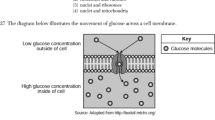Summary
Molecular biology conferred enormous progresses in biosciences during the past few years. This paradigm permutation in biological research certainly challenges biological education. Nevertheless, this is no reason to fundamentally reorganise biological education at the universities. A most entire view of the matter should remain a central request which meets the capacity and imagination of students. Selected biological phenomena taken from the traditional treasury remain suitable in the future too to mediate basic biological ways ot thinking. Forthcoming syllabuses, however, will necessitate the expansion of this concept. The scope of the present contribution is to show, how the integration of molecular biology in the teaching of classical disciplines of biology may be reached. Choosing ecology and environmental biology as examples, molecular biology will not only strengthen explanation models of cause-effect relationships in these disciplines, but also will facilitate the interconnections to interdisciplinary fields such as health education, social, and political education. This may result in an entire structural concept of classical and molecular biology.
Similar content being viewed by others
References
Efferth, T.; Volm, M. (1992) Immunohistochemical detection of P-glycoprotein, glutathione S-transferase pi and DNA topoisomerase II in human tumors. Oncology 49: 368–375.
Efferth, T.; Fabry, U.; Osieka, R. (1997) Apoptosis and daunorubicin resistance to daunorubicin in human leukemic cells. Leukemia 11: 1180–1186.
Fearon, E. R.; Vogelstein, B. (1990) A genetic model for colorectal tumorigenesis. Cell 61: 759–767.
Feyereisen, R. (1995) Molecular biology of insecticide resistance. Toxicol. Lett. 82: 83–90.
Guillemaud, T.; Rooker, S.; Pasteur, N.; Raymond, M. (1996) Testing the unique amplification event and the worldwide migration hypothesis of insecticide resistance genes with sequence data. Heredity 77: 535–543.
Hainaut, P. (1995) The tumor suppressor protein p53: a receptor to genotoxic stress that controls cell growth and survival. Curr. Opin. Oncol. 7: 15–16.
Harms, C. T.; Armour, S. L.; DiMaio, J. J.; Middlesteadt, L. A.; Murray, D.; Negretto, D. V.; Thompson-Taylor, H.; Weymann, K.; Montoya, A. L.; Shillito, R. D. et al. (1992) Herbicide resistance due to amplification of mutant acetohydroxyacid synthase gene. Mol. Gen. Genet. 233: 427–435.
Knowles, M. (1975) Self-directed learning. Association Press. New York.
Kuhn, T. S. (1981) Die Struktur wissenschaftlicher Revolutionen. Suhrkamp Taschenbuch Verlag. Frankfurt a. M.
Morgan, J. A. (1991) Molecular biology: new tools for studying microbial ecology. Sci. Prog. 75: 265–277.
Schenk, H. E. A.; Bayer, M. G.; Zook, D. (1987) Cyanelles — from symbiont to organelle. Ann. N. Y. Acad. Sci. 503:151–167.
Schwartz, R. M.; Dayhoff, M. O. (1978) Origin of prokaryotes, eukaryotes, mitochondria, and chloroplasts. Science 199: 395–403.
Sitte, P.; Eschenbach, S. (1991) Cytosymbiosis and its significance in cell evolution. Prog. Bot. 53: 29–43.
Song, K.; Lu, P.; Tang, K.; Osborn, T. C. (1995) Rapid genome change in synthetic polyploids of Brassica and its implications for polyploid evolution. Proc. Nat. Acad. Sci. U.S.A. 92: 7719–7723.
Stewart, C. A.; Thompson, P. J. (1996) Review: The biochemistry of common aeroallergens. Clin. Exp. Allergy 26: 1020–1041.
Toulmin, S. (1983) Kritik der kollektiven Vernunft. Suhrkamp Taschenbuch Verlag. Frankfurt a. M.
Umestu, D. T.; DeKruyff, R. H. (1997) Th1 and Th2 CD4+ cells in the pathogenesis of allergic diseases. Proc. Soc. Exp. Biol. Med. 215: 11–20.
Volm, M.; Zerban, H.; Mattern, J.; Efferth, T. (1990) Overexpression of P-glycoprotein in rat hepatocellular carcinomas induced with N-nitrosomorpholine. Carcinogenesis 11: 169–172.
Author information
Authors and Affiliations
Corresponding author
Rights and permissions
About this article
Cite this article
Efferth, T. Didactics of molecular ecology. Theory Biosci. 120, 139–148 (2001). https://doi.org/10.1007/s12064-001-0013-0
Received:
Accepted:
Issue Date:
DOI: https://doi.org/10.1007/s12064-001-0013-0




